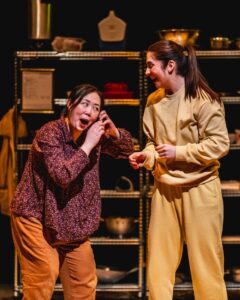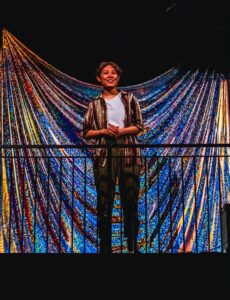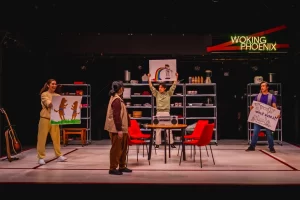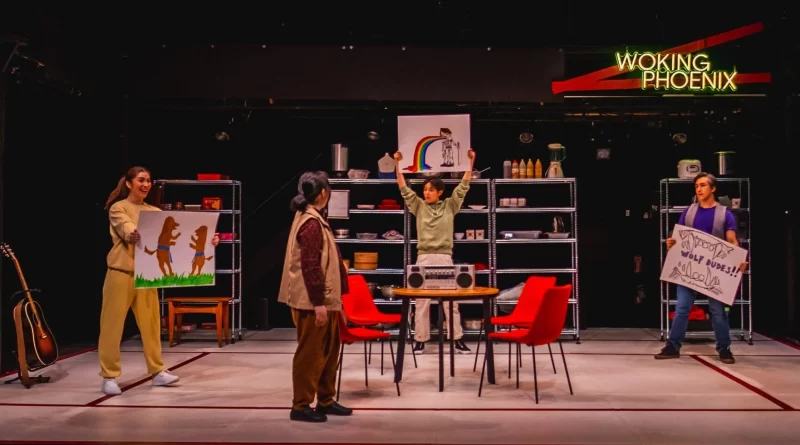“Woking Phoenix” is like comfort food at an unpretentious, authentic restaurant
“Welcome to Woking Phoenix! We’re so glad you’re here. Please sit anywhere you’d like.”

With these warm words, a Chinese-Canadian family in an unnamed Canadian small town welcomes customers to their restaurant. It’s the only Chinese food restaurant in town. And for more than two decades, they operate it with hope, pride and dedication.
A Theatre Passe Muraille and Silk Bath Collective co-production, Woking Phoenix tells an engrossing, intimate and strongly-acted tale of generational change and family survival. The show is co-created, directed and produced – with energy and sensitivity – by the Collective’s three principals: Aaron Jan, Bessie Cheng and Gloria Mok (莫嘉詠).
When the family’s father leaves, Ma (Phoebe Hu 胡馨勻) is left to raise her three children, played at all ages from preschool to their twenties by the show’s other three actors. Rebellious and artistic, oldest daughter Charlie (Charlene) is brought to vivid life by show co-creator Bessie Cheng. Charlie is searching outside her family and culture to understand who she really is. The middle child is aspiring rock star son Vince, played with a winning mix of bluster and fragility by Richard Lam. Youngest daughter Iris, played by a bright-eyed and spirited Madelaine Hodges (賀美倫), is loyal, industrious, and indefatigable.
All four members of the family are looking for belonging in a world of Canada Day parades and schoolyard ostracism that “others” them collectively and individually. The restaurant, with its neon sign perched above the righthand side of the stage, is both the setting of the play and the anchor of the family’s identity. Ma decides on the name Woking (pronounced “Walking”) Phoenix for joyous and punningly aspirational reasons based on using woks and aspiring to be kings. (The closeness of the name to that of actor “Joaquin Phoenix” is likely just a happenstance pun . . . but the actor, who won an Oscar for his performance in Joker, is known for his immersive method acting style. This could almost be a sideways comment on the function of the restaurant in the lives of the family – does it require of them the kind of suppression of individual self required of Phoenix the actor?)

The stage area conjures the restaurant with a simple and cheerfully functional set consisting of two items. Running across the back of the stage is a long unit of shelves filled with pots, cooking implements, dishes and food supplies. A table periodically appears in front. During business hours, customers sit here, while before and after the restaurant opens, the family (which Ma calls her “best team”) sit here. They work and share meals together successfully . . . until competition tests their restaurant and their place in the community. Meanwhile, the vertical catwalk spaces above and to the side of the stage are used to conjure spaces and places beyond the Woking Phoenix’s nexus of family identity – mostly places in the big city of Toronto, where the children go in quest of expanding their identities.
Hu’s Ma is the magnetic and deeply sympathetic centre of the family and the play itself. As the show progresses, her seemingly tireless energy and boundless ambition are whittled down by threats to the business and the family. A symbol and source of comedy is the boom box which the resourceful Ma finds at a garage sale. This outdated and moribund technology becomes a vehicle for her endless quest to improve her English, and provides the danceable soundtrack for individual and family aspirations. But as the decades pass, the boom box glitches more and more – in some ways like the family itself.
In a show whose ethos is so humble, plain-spoken and unpretentious, Woking Phoenix’s use of sound and dance is a lovely and poetic surprise. Maddie Bautista’s brilliant sound design and composition conjure surprising, symbolic sound effects to stand in for the words of anyone outside the family. Alone in this small town, this Chinese-Canadian family speaks their own language of connection (sometimes English, sometimes Mandarin) that we – and they – understand. And so, too, do they dance their connection – in surprising ways, at surprising moments. Moving together rhythmically, they trace out their most intimate bonds in choreography created by Hanna Kiel (길현아) and the performers. In a sense, this play is really one big, beautiful family dance.

But that dance is not without its sorrows and challenges. Each of the second-generation children navigates a different path based on their different talents, interests, and the relationships which they prioritize. One leaves for the big city, one leaves and returns, and one stays. What each does and where they end up is a function of actively danced negotiation – between filial duty and individual aspiration, between sibling, parental and other relationships, and between culture and experience.
Ultimately, this is a simple and sincere story of one family formed from four different individuals. We root for them all as they find themselves and, phoenix-like, discover their deeper connection to each other. Unpretentious, hearty and heartfelt, Woking Phoenix goes down like a satisfying meal at an authentic restaurant, where one tasty scene follows another . . . until the deeply touching final scene shows us we are full.
Woking Phoenix continues until April 27, 2024 at Theatre Passe Muraille. Reserve tickets at passemuraille.ca.
©Scott Sneddon, SesayArts Magazine, 2024
[\responsivevoice]
About The Author
Scott Sneddon
Scott Sneddon is Senior Editor on SesayArts Magazine, where he is also a critic and contributor.
Visit About Us > Meet the Team to read Scott’s full bio …


